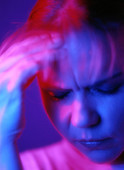
WEDNESDAY, Feb. 6 (HealthDay News) — Migraine sufferers in search of a non-medicinal alternative for relief may be encouraged by new Belgian research that suggests that 20 minutes a day of nerve stimulation might cut back on the frequency of attacks.
The finding stems from a small study involving 67 migraine patients. All participants were outfitted with a wearable device called a “supraorbital transcutaneous stimulator,” or STS, which was placed on the forehead and designed to deliver electrical stimulation to the patient’s supraorbital nerve.
Use of the stimulator device was found to be “effective and safe as a preventive therapy for migraine,” according to the study.
Study lead author Dr. Jean Schoenen, of the headache research unit in the department of neurology & GIGA-neurosciences at Liege University, and colleagues described the team’s findings in the Feb. 6 online issue of Neurology.
Study participants were aged 18 to 65 and were being treated for migraines at one of five headache clinics in Belgium. All routinely experienced a minimum of two — and an average of four — migraine attacks per month. Although some had previously tried standard drug-based treatments, none had been taking any type of preventive chronic anti-migraine treatment in the three months leading up to the study launch.
Between 2009 and 2011, the patients were randomly divided into two groups. Both were given identical self-adhesive stimulation electrode pads to place on their forehead for 20 minutes daily over a three-month period. However, one group’s electrode was a sham device that exerted an ineffectively weak electrical pulse, while the second group wore a working supraorbital transcutaneous stimulator.
Participants kept migraine diaries, which revealed that although migraine severity did not decrease much, by the third month of the study, those using the working devices saw the frequency of their attacks drop from about seven per month to fewer than five.
Sham device users experienced no such drop-off.
In addition, 38 percent of the working device users saw their attacks drop off by half or more, compared with 12 percent for those using fake stimulators.
Monthly use of anti-migraine drugs to cope with migraine attacks when they occurred dropped by nearly 37 percent among supraorbital transcutaneous stimulator users, with no drop among the sham group.
Schoenen and her associates said that the exact mechanism by which electrical stimulation seems to help migraine sufferers remains unclear, though they suggested it might have something to do with the neurological prompting of a “sedative effect.”
Perhaps most important was the finding that none of the stimulator users experienced any side effects.
The researchers point to a previously conducted analysis of studies focusing on the impact of taking a 100-milligram dosage of topiramate — a standard migraine drug. That analysis showed that the drug was considerably more effective than the nerve stimulator devices in its ability to reduce the frequency of monthly attacks.
At the same time, however, the analysis revealed that half of all topiramate patients had experienced drug-related side effects, compared with none among the stimulation device users. A quarter of all topiramate patients had ended up dropping the drug altogether due to the harshness of the side effects.
Commenting on the new study findings, Dr. Gretchen Tietjen, chair of neurology at the University of Toledo Medical Center in Ohio, and director of the center’s headache treatment and research program, said: “It’s certainly true that for some people side effects are really problematic. Depending on the class of medication, there can be problems with weight gain, hair loss, thinking, sedation, dry mouth, fatigue, dizziness, light-headedness and, for men, particular sexual side effects.”
Tietjen added, “So there are a lot of very real issues here. And looking for other approaches like this definitely makes sense.”
Study author Schoenen noted that apart from Belgium, the supraorbital transcutaneous stimulator is currently also available in France and Canada, while the U.S. Food and Drug Administration approval process is still “ongoing.”
Meanwhile, several different follow-up investigations are planned. One will look at the device’s impact on patients who suffer more frequent (chronic) migraines, while another will explore a newer stimulation approach in which a similar device will target the suboccipital nerve (also found in the head) in addition to the supraorbital nerve.
That said, Schoenen cautioned that as a practical matter the cost of the device in question is “not trivial,” currently priced in Belgium at 300 Euro (about $400). She suggested that patients considering the intervention might want to start out by renting the stimulator for two to four months, to see whether or not they realize any benefits before making a purchase.
More information
For more on migraines, visit the U.S. National Library of Medicine.

